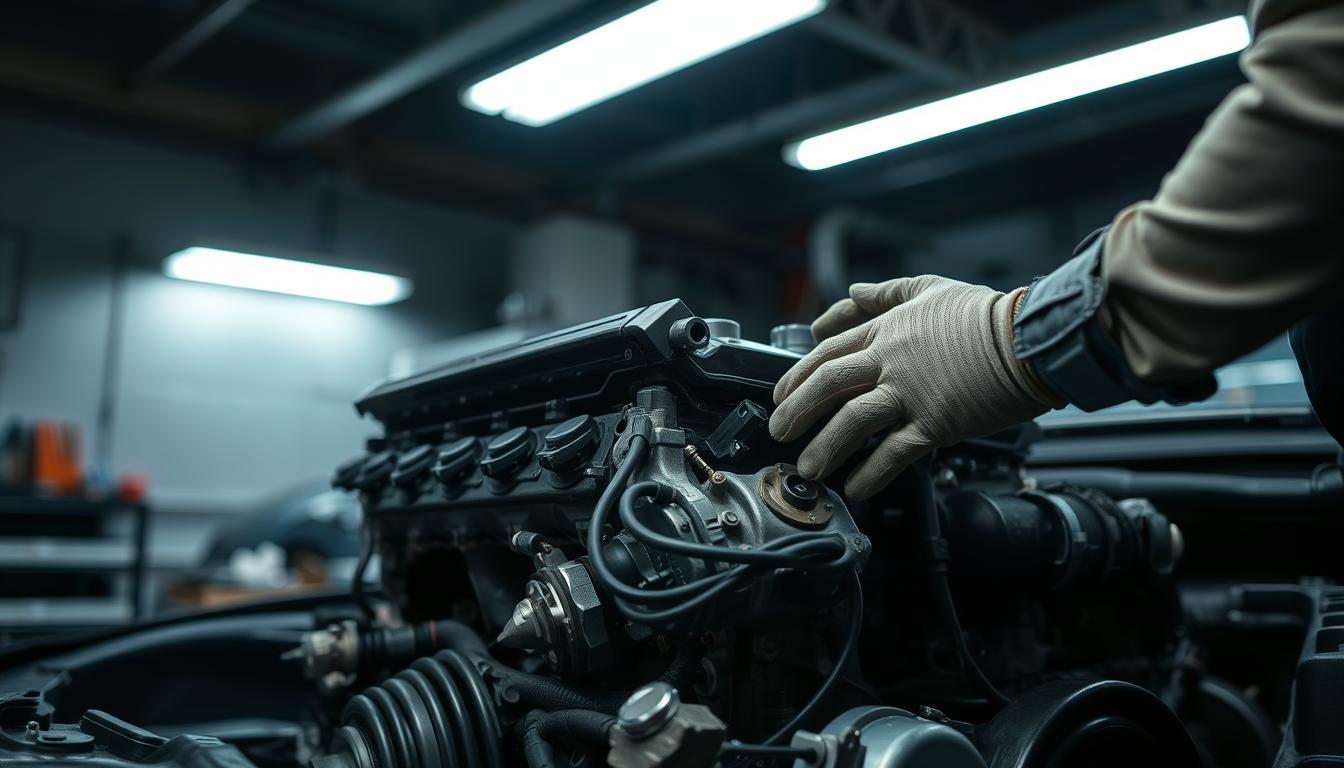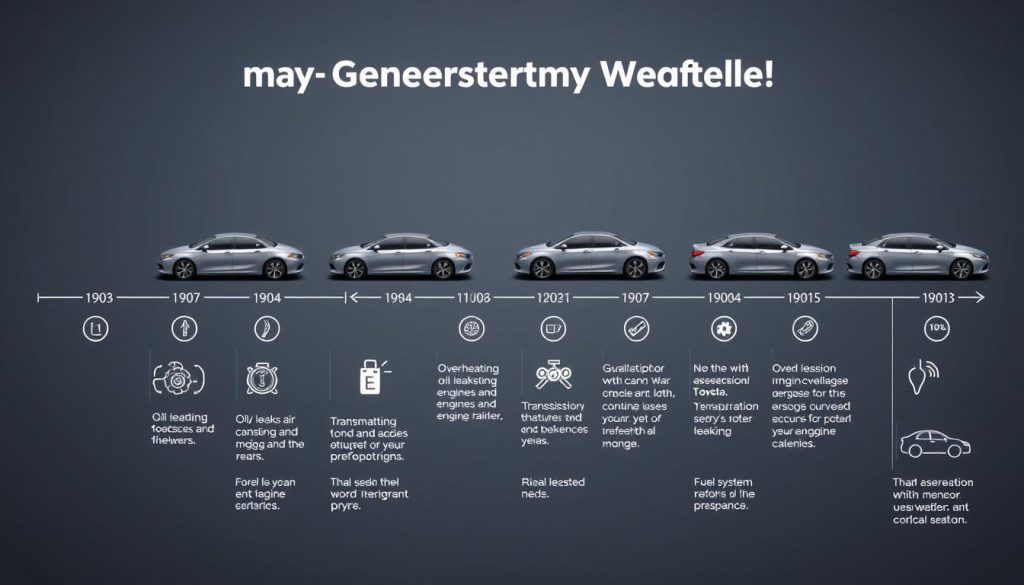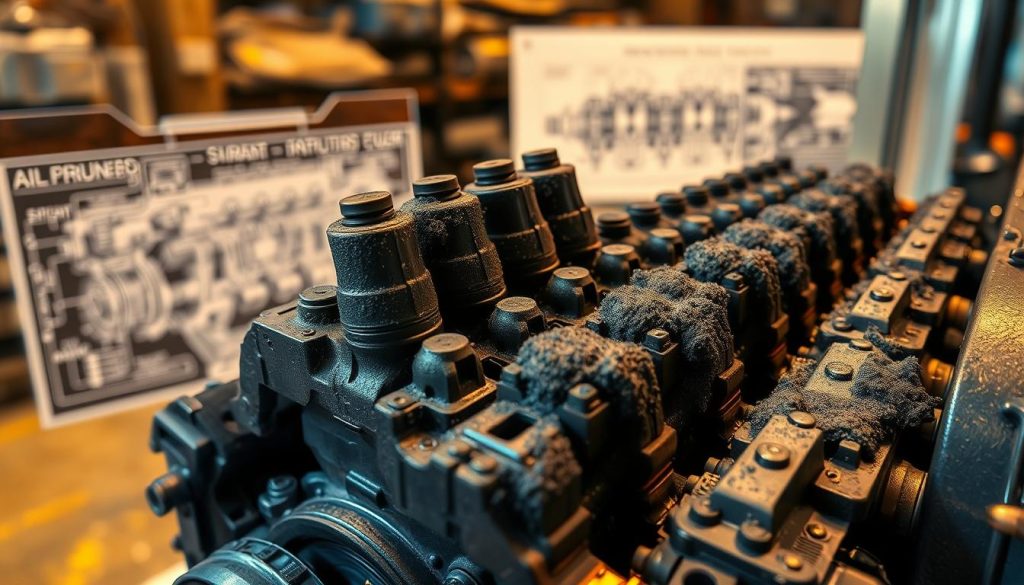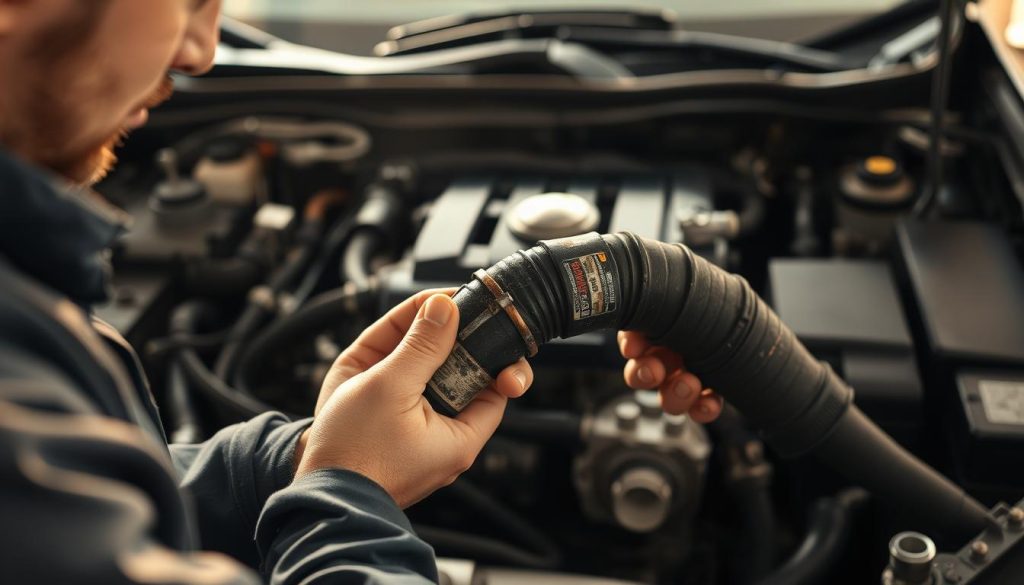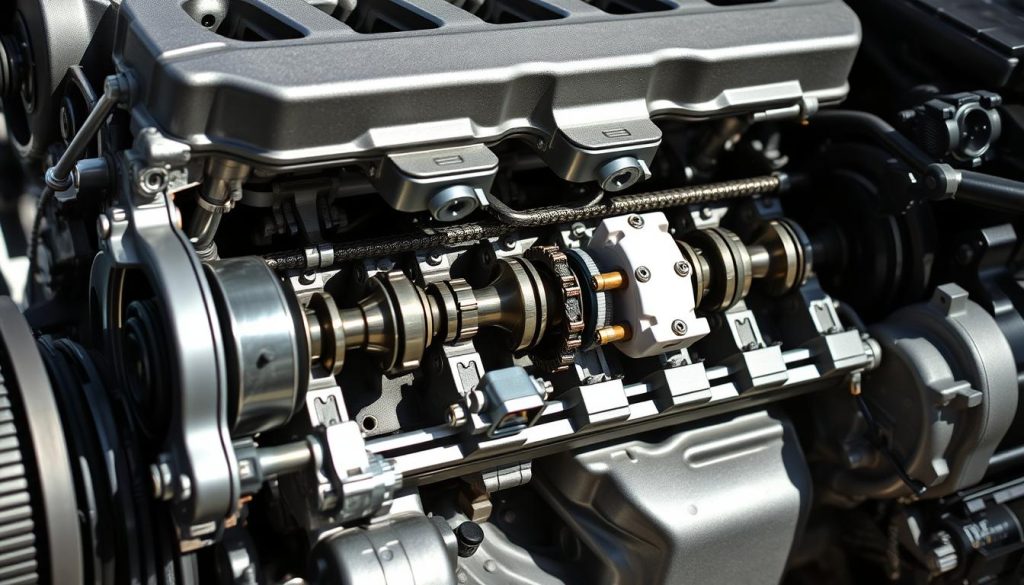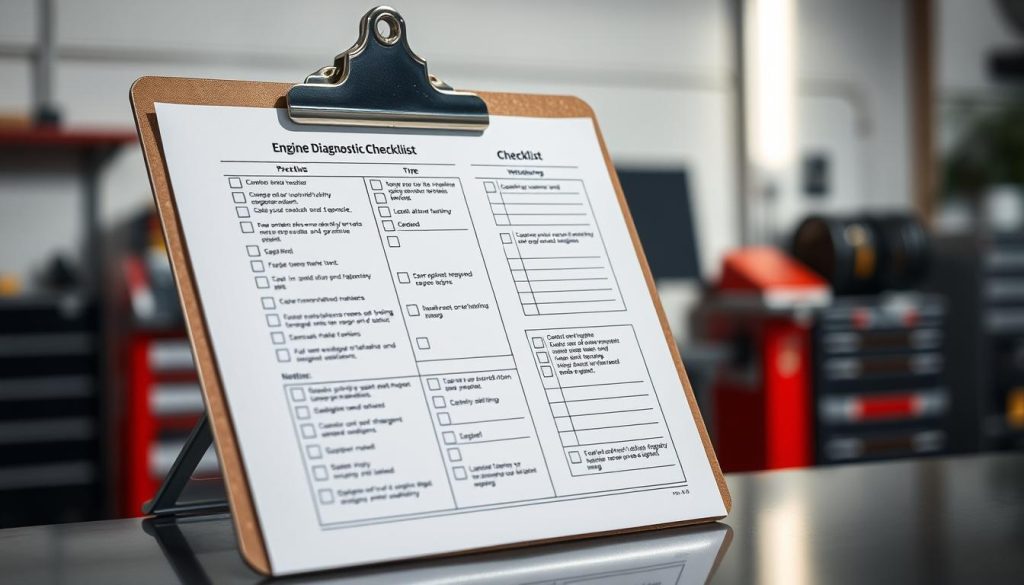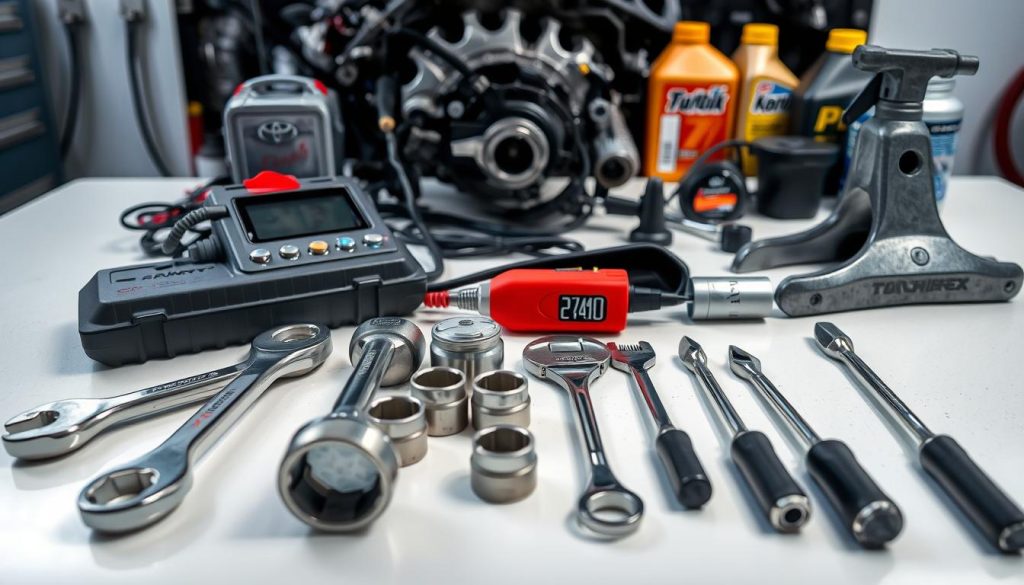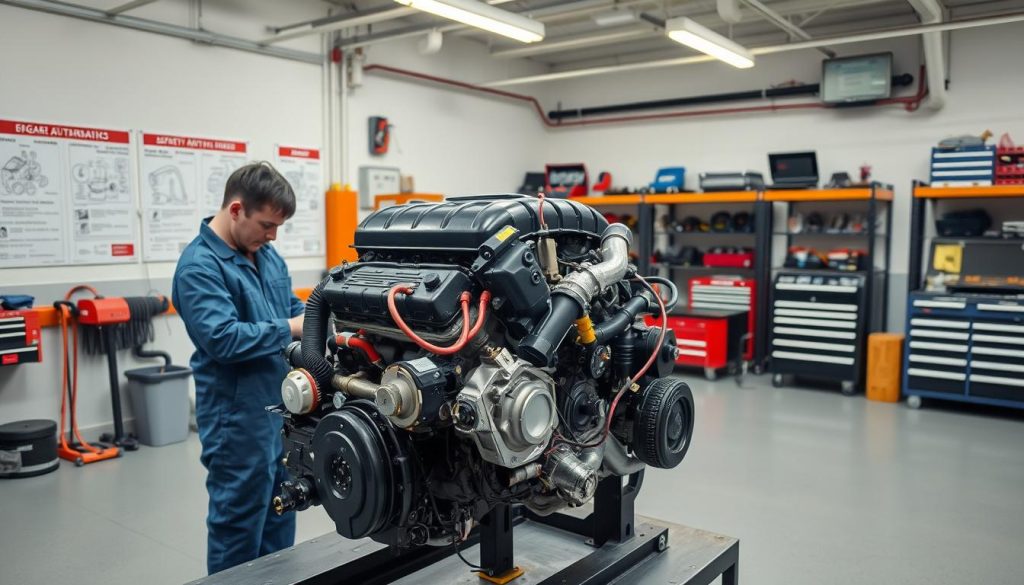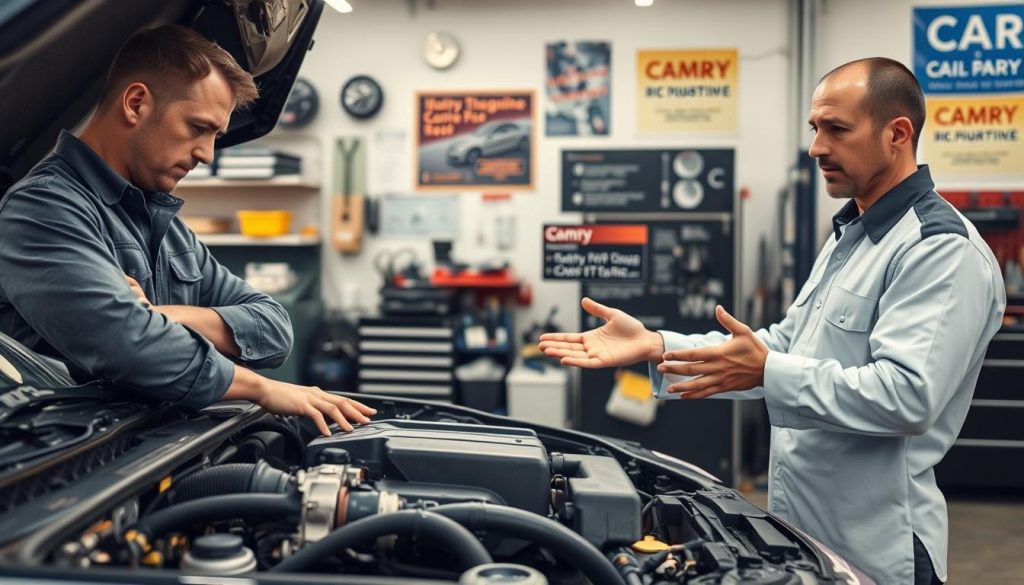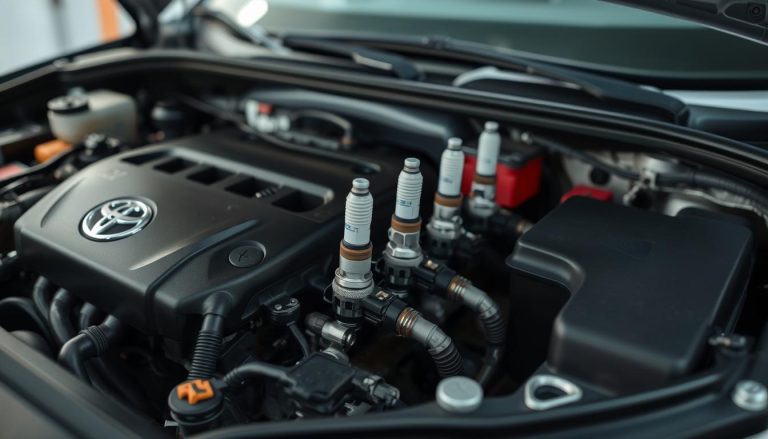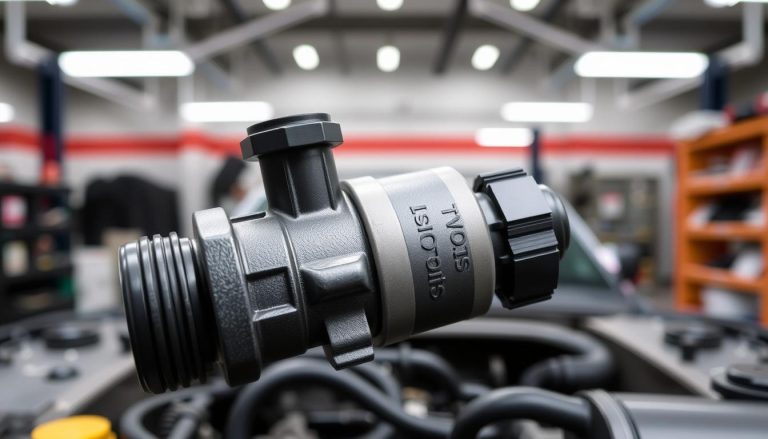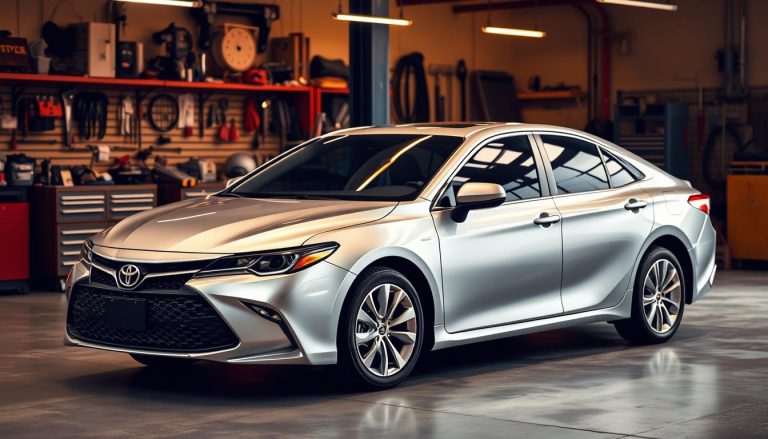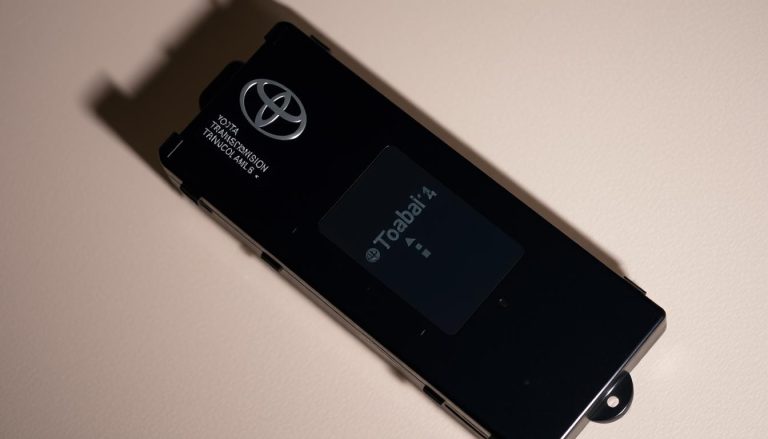Camry Engine Problems: Causes, Symptoms, and Fixes
The Toyota Camry is a top choice for many Americans. It’s known for its reliable performance over the years. But, even the most trusted cars can have mechanical concerns that need fixing. Spotting these issues early can save you time, money, and stress.
This guide covers the most common Toyota Camry engine issues owners face. We’ll look at engine failure symptoms, find the causes, and offer fixes for different problems. If you hear odd noises, see performance drops, or get warning lights, this guide will help you understand what to do next.
Key Takeaways
- Spotting Camry motor problems early can save you from expensive fixes and keep your car running longer.
- Common signs include strange noises, less power, and dashboard lights.
- Following regular maintenance can stop many issues before they get worse.
- Get a pro to check your car if you notice several problems at once.
- Knowing your car’s maintenance history helps when you’re trying to figure out what’s wrong.
- Some problems can be fixed easily, but others need a mechanic’s help.
Understanding Your Toyota Camry’s Engine System
Knowing about Camry engine components helps spot problems early. It also lets you keep your car in top shape and talk well with mechanics.
Your Toyota Camry might have a four-cylinder or V6 engine, based on its year and trim. These engines use cutting-edge tech for reliable performance.
- Variable Valve Timing with intelligence (VVT-i) – optimizes engine performance
- Direct injection systems – improve fuel efficiency
- Advanced emission control components – reduce environmental impact
- Sophisticated engine management sensors – monitor performance
The engine control unit (ECU) is your engine’s brain. It gets data from sensors and adjusts performance in real-time. It watches over air-fuel ratios and exhaust emissions.
Knowing about Toyota engine design helps you see how parts work together. The timing chain system, fuel injection, ignition coils, cooling system, and lubrication system all play a part. When one part fails, it can affect others.
Each part is key to the engine’s operation. The cooling system keeps it from overheating, and the lubrication system cuts down on friction. Understanding these connections shows why small issues can turn into big problems if not fixed.
Because everything is connected, regular maintenance is essential. Proper care of all engine components keeps your Camry running well and lasting longer.
Most Common Camry Engine Problems by Generation
Different Camry generations face unique engine issues. Knowing these Camry generation problems helps you keep your car in top shape. Each generation brings new tech but also new problems.
Knowing your model’s specific issues helps with maintenance. This info is key for budgeting and scheduling car care.
2007-2011 Sixth Generation Issues
The sixth generation Camry has a big problem: oil consumption. Its 2.4-liter engines use too much oil, needing constant checks. Many owners add a quart every 1,000 miles.
Carbon buildup on intake valves hurts performance and fuel efficiency. Regular cleaning of the intake helps avoid these issues.
2012-2017 Seventh Generation Concerns
The seventh generation Camry improved oil use but has timing chain stretch issues. These engines make rattling noises at start-up, showing chain wear. VVT-i system failures also cause check engine lights to flash often.
The 2.5-liter engines burn some oil, but less than before. Model year engine issues often involve failing variable valve timing parts.
2018-2024 Eighth Generation Problems
Newer Camrys have advanced tech but face challenges. Carbon buildup in direct injection engines needs more cleaning. Some models show early timing chain wear, despite design updates.
Cooling system issues can also happen. Toyota engine recalls have fixed some problems. But, owners should check coolant levels often. Catching overheating early prevents damage.
Oil Burning and Excessive Oil Consumption
Many Camry owners find their engines use oil too fast, leading to expensive repairs. This issue affects thousands, mainly those with 2.4-liter and 2.5-liter engines. Excessive oil consumption can cause serious engine damage if not fixed.
Drivers often need to add oil more often than usual. Some engines might need a quart every 1,000 miles. Toyota sees this as too much and might cover the repair costs under warranty.
Oil burning problems usually come from worn-out parts. Piston rings and valve seals are the main offenders. They let oil get into the combustion chamber, where it burns with fuel.
Oil Consumption Testing Process
Begin by changing the oil and noting how much you add. Drive 1,000 miles normally. Then, check and record the oil level.
Do this for three intervals. This method is reliable. Keep detailed records of dates and mileage. Your records help mechanics find the problem faster.
| Test Interval | Miles Driven | Oil Added (Quarts) | Consumption Rate |
|---|---|---|---|
| First 1,000 | 1,000 | 0.8 | Normal Range |
| Second 1,000 | 2,000 | 1.2 | Excessive |
| Third 1,000 | 3,000 | 1.1 | Excessive |
Identifying Ring and Seal Problems
Piston ring failure causes blue smoke when accelerating. Worn valve seals make smoke when starting after parking overnight. A compression test can pinpoint cylinder issues.
Professional diagnosis might include a borescope inspection. This shows the condition of the cylinder walls and valve areas. Fixing oil consumption issues quickly prevents major engine damage.
Carbon Buildup in Direct Injection Engines
Direct injection engines in newer Camry models face carbon buildup problems. This creates maintenance challenges for owners. Unlike traditional systems, direct injection technology sprays fuel directly into the combustion chamber. This leaves intake valves exposed to oil vapors and combustion byproducts, forming stubborn deposits.
The issue typically becomes noticeable around 60,000 to 80,000 miles. Short trips and city driving speed up carbon formation. These direct injection issues can significantly impact your engine’s performance and fuel economy over time.
Recognizing Carbon Deposit Warning Signs
Several symptoms indicate carbon accumulation on your intake valves. Rough idling often appears first, followed by hesitation during acceleration. You might notice reduced power output and poor fuel economy.
Engine knock or ping under load signals advanced carbon buildup problems. Pay attention to changes in idle quality and throttle response. Sometimes a check engine light appears due to misfiring cylinders caused by restricted airflow.
Professional vs. DIY Cleaning Methods
Professional diagnosis uses a borescope to examine valve surfaces directly. For intake valve cleaning, you have several options depending on severity.
DIY cleaning involves specialized sprays designed for direct injection engines. This method requires removing the intake manifold for proper access. Apply cleaning solution to valve surfaces and allow time for deposits to dissolve.
Severe buildup requires professional walnut shell blasting. This process uses crushed walnut shells to physically remove stubborn carbon without damaging delicate valve surfaces.
| Cleaning Method | Severity Level | Cost Range | Effectiveness |
|---|---|---|---|
| DIY Spray Cleaning | Light to Moderate | $30-60 | 70% removal |
| Professional Chemical Clean | Moderate to Heavy | $200-400 | 85% removal |
| Walnut Shell Blasting | Heavy Buildup | $400-800 | 95% removal |
| Preventive Additives | Prevention Only | $15-25 | Maintenance |
Timing Chain Stretch and Tensioner Failure
Timing chain problems are serious issues for your Toyota Camry’s engine. Unlike belts, timing chains last your engine’s lifetime. But, they can face problems that harm your engine.
The timing chain ensures your crankshaft and camshaft work together. This is key for valves to open and close correctly. If the chain tensioner fails, this timing gets off, causing poor performance and serious damage.
Toyota’s 2012-2017 Camry models are more prone to these issues. Problems with the VVT-i system often happen with timing chain stretch. This triggers check engine lights and lowers performance.
Recognizing Timing Chain Noise
A rattling sound from the engine’s front is the first sign. This timing chain noise happens during cold starts when oil pressure is building.
Look out for these signs:
- Rattling noise lasting 3-10 seconds after startup
- Metallic grinding sounds showing severe wear
- Noise that gets worse over time
- Rough idling and less power
Inspection and Replacement Guidelines
Experts use special tools to check timing chain slack. They look at the tensioner and timing cover for wear.
Replacing the chain and parts needs removing the timing cover. It’s a complex job that costs $1,500-$3,000 based on your engine.
Ignoring these issues can lead to valve-to-piston contact. This can destroy your engine and need a full replacement.
Engine Knocking and Knock Sensor Issues
That metallic pinging sound from your Camry’s engine isn’t something to ignore. Engine knocking problems occur when fuel burns too early in the combustion chamber, creating damaging pressure waves. Your Camry’s knock sensor acts as an early warning system, detecting these vibrations and telling the engine computer to adjust timing.
When knock sensor failure happens, your engine loses this protection. The result can be serious engine damage if detonation goes unchecked. Common symptoms include reduced power, poor fuel economy, and that distinctive knocking sound during acceleration.
Diagnosing Pre-Ignition Problems
Start your diagnosis by checking your fuel. Pre-ignition issues often stem from using low-octane gas when your Camry requires premium fuel. Listen carefully during acceleration, specially when climbing hills or carrying heavy loads.
Carbon buildup can also trigger knocking sounds. If your engine has high mileage, carbon deposits may increase compression ratios beyond design limits. This creates the perfect conditions for pre-ignition problems to develop.
Temperature plays a role too. An overheating engine is more prone to knock because hot metal surfaces can ignite fuel prematurely.
Knock Sensor Testing and Replacement
Professional diagnosis involves using an oscilloscope to test knock sensor signals. The sensor should generate voltage spikes when the engine experiences detonation. Knock sensor failure shows up as weak or absent signals during testing.
Replacement requires accessing the sensor on your engine block. Disconnect the electrical connector first, then remove the sensor with a deep socket. Proper torque specifications are critical during installation to ensure accurate vibration detection.
Don’t delay repairs when you hear knocking sounds. Uncontrolled detonation can crack pistons, damage bearings, and destroy your engine completely.
Cooling System Problems and Overheating
Cooling system failure can lead to a big engine rebuild. It’s key to catch it early. Your car’s cooling system has many parts like the radiator and water pump. If any part fails, engine overheating can harm your engine.
Look out for these signs of cooling system trouble:
- Temperature gauge reading higher than normal
- Frequent coolant loss needing top-offs
- Visible steam from the engine bay
- Sweet-smelling coolant odors inside the cabin
- White or greenish residue around engine parts
Fixing cooling system issues early can save a lot of money. Immediate attention keeps your car running well and saves your money.
Leak Detection Methods
Coolant leak detection begins with a visual check. Look at hose connections and the radiator for leaks. Also, check for white or greenish residue on engine parts.
A cooling system pressure tester finds small leaks. It pressurizes the system to show hidden problems. Always check coolant levels when the engine is cold to avoid burns.
Component Diagnosis
Thermostat issues show as overheating or slow warm-up. Test by watching engine temperature during warm-up. See when the upper radiator hose gets hot to check the thermostat.
Water pump problems often show as coolant leaks or bearing noise. A failing water pump can cause engine overheating even with enough coolant. A pro can use tests like pressure testing and thermal imaging to find the problem.
VVT-i System Failures and Solenoid Problems
Knowing about VVT-i system failures is key for Camry owners to keep their engine running well. Toyota’s Variable Valve Timing with intelligence system adjusts valve timing based on driving conditions. If this system fails, you’ll see less power and poor fuel economy.
The VVT-i system uses oil pressure to control cam phasers. Solenoids receive signals from your Engine Control Module to manage this timing. Signs of trouble include rough idling, rattling noises, and check engine lights.
Most VVT solenoid issues come from dirty oil or not changing oil often enough. The system needs clean oil to work right. Using the wrong oil can make these problems worse.
Common Error Codes
Variable valve timing failure shows up as specific diagnostic trouble codes. Your OBD-II scanner will show these codes when the VVT-i system goes wrong. Each code tells you which camshaft or bank has timing problems.
| Error Code | Description | Affected Component | Common Cause |
|---|---|---|---|
| P0010 | Intake Camshaft Position Actuator | Bank 1 VVT-i Solenoid | Dirty or failed solenoid |
| P0020 | Intake Camshaft Position Actuator | Bank 2 VVT-i Solenoid | Oil passage blockage |
| P0011 | Camshaft Timing Over-Advanced | Bank 1 Cam Phaser | Worn cam phaser |
| P0021 | Camshaft Timing Over-Advanced | Bank 2 Cam Phaser | Low oil pressure |
Solenoid Cleaning and Replacement
Start by scanning for error codes to find out which bank needs work. VVT-i system problems often get fixed by cleaning the solenoid with carburetor or brake cleaner.
To get to the solenoids, remove the engine cover. Clean the solenoid screens of oil sludge and varnish. If cleaning doesn’t solve the problem, you’ll need to replace the solenoid.
Use genuine Toyota parts or high-quality aftermarket ones when replacing solenoids. Proper torque specifications during installation prevent future problems. Regular oil changes with the right viscosity oil also help avoid VVT-i system failures.
Step-by-Step Engine Diagnostic Process
Modern engine diagnosis uses both old and new methods. Mechanics follow engine diagnostic procedures to avoid mistakes and save money. This method helps find problems fast and boosts your confidence in fixing them.
The first step is to get details from the vehicle owner. Ask about when problems happen, driving conditions, and recent maintenance. This info helps plan your diagnosis and saves time.
Visual Inspection Checklist
Begin with a detailed look at engine parts. Look for any obvious issues that don’t need special tools. Check fluid levels and look for leaks around key areas.
Check belt condition and tension. Worn belts can harm charging and cooling systems. Also, inspect air intake for damage or loose connections that cause leaks. These engine troubleshooting steps often find simple fixes for big problems.
OBD-II Code Reading and Interpretation
Use a scanner to get diagnostic trouble codes and live data. Modern Camry engines store codes that help diagnose issues. But remember, codes show symptoms, not the cause.
OBD-II scanning shows sensor readings and fuel trim values in real-time. A P0171 code might mean a vacuum leak, faulty fuel injector, or mass airflow sensor issue. Correctly understanding codes helps avoid replacing parts unnecessarily.
Diagnostic trouble codes are like symptoms of a disease – they tell you something is wrong, but not necessarily what caused the problem.
Engine Performance Testing Methods
Advanced tests include compression and fuel pressure tests. These check cylinder condition and fuel delivery. Ignition system tests ensure spark timing and intensity.
Use oscilloscopes to analyze sensor waveforms and actuator patterns. This tool finds problems scanners might miss, like intermittent issues.
| Test Type | Purpose | Normal Range | Tools Required |
|---|---|---|---|
| Cylinder Compression | Evaluate engine internal condition | 140-180 PSI | Compression gauge |
| Fuel Pressure | Verify adequate fuel delivery | 44-50 PSI | Fuel pressure gauge |
| Ignition Timing | Check spark delivery accuracy | 10° BTDC at idle | Timing light |
| Vacuum Test | Assess engine breathing | 17-22 inches Hg | Vacuum gauge |
Essential Tools for Camry Engine Repairs
The right automotive repair tools can make a big difference. They turn tough engine repairs into easier tasks. Quality tools also protect your car’s expensive parts from damage.
Knowing what mechanic tool requirements are helps you build a good toolkit. Start with the basics and add more as you learn. This way, you spend money wisely and have the right tools when you need them.
Basic Mechanic’s Tool Set
Every Camry owner needs basic hand tools for upkeep. A good metric socket set covers most Toyota bolts. Combination wrenches are useful for tight spots.
A torque wrench is key for avoiding over-tightening. It’s important for oil drain plugs and timing parts. You’ll also need quality screwdrivers and pliers for oil changes and small repairs.
Diagnostic Equipment and Specialty Tools
Modern engine diagnostic equipment makes fixing problems easier. An OBD-II scanner reads trouble codes and monitors data. Digital multimeters check electrical circuits and sensor voltages.
Special tools solve specific problems well. Compression testers check cylinder health, and fuel pressure gauges find fuel system issues. Timing tools ensure the engine runs right during repairs.
| Tool Category | Essential Items | Cost Range | Skill Level |
|---|---|---|---|
| Basic Hand Tools | Socket set, wrenches, torque wrench | $150-$300 | Beginner |
| Diagnostic Equipment | OBD-II scanner, multimeter | $100-$500 | Intermediate |
| Specialty Tools | Compression tester, timing tools | $200-$800 | Advanced |
| Safety Equipment | Jack stands, safety glasses | $75-$200 | All levels |
Safety Guidelines for Engine Work
Following workshop safety guidelines is key to safe engine work. Each repair task has risks that can harm you without caution. By following safety rules, you avoid burns, cuts, chemical exposure, and crushing injuries.
Hot engine parts are a burn risk. Always wait for your engine to cool down before starting work. Even when it’s cool, wear protective clothes to guard against burns.
Personal Protective Equipment Requirements
Wearing the right safety gear is your first line of defense. Safety glasses shield your eyes from debris, metal shavings, and chemicals. Opt for wrap-around styles for better protection.
Chemical-resistant gloves keep your hands safe from oils, coolants, and solvents. If your gloves tear, replace them right away. Steel-toed boots also prevent foot injuries from dropped tools and heavy parts.
Wear long pants and sleeves to protect your skin from sharp edges and hot surfaces. Make sure your clothes are not loose to avoid getting caught on moving parts or tools.
Safe Vehicle Lifting and Support Procedures
Lifting vehicles is very dangerous and can cause serious injuries. Never rely solely on hydraulic jacks for support during long work sessions.
Use jack stands rated for your Camry’s weight. Place stands on solid, level ground at the points specified by the manufacturer. Before starting work, gently shake the vehicle to check if it’s stable.
Engine repair also needs electrical safety. Always disconnect the battery before working on ignition or fuel systems. This prevents electrical shock and fires.
Common Camry Engine Problems: DIY vs Professional Repairs
Knowing what repairs you can do yourself and what needs a pro can save you money and time. It’s all about repair complexity assessment. This depends on your skills, tools, and the repair’s specifics. Choosing wrong can make a simple fix very costly.
Think about your mechanical skills, tools, and the cost of mistakes. Small errors on big repairs can cost thousands.
Repairs You Can Handle at Home
DIY engine repairs are best for simple tasks like oil changes and spark plug swaps. These need basic tools and are low-risk if done wrong.
More complex tasks like oxygen sensor replacement and ignition coil swaps need more knowledge and tools. But, with the right research, they’re doable for home mechanics.
Fuel filter and PCV valve changes are also DIY-friendly. Success comes from following the manufacturer’s guide and being patient.
When to Visit a Professional Mechanic
Professional mechanic services are key for complex engine work. Jobs like timing chain replacement need special tools and skills. Internal repairs, like piston ring replacement, require machine shop services and a lot of disassembly.
Electrical engine system diagnosis needs expensive tools. Pros have the training to read complex error codes right. Their knowledge avoids costly misdiagnosis and part replacements.
Warranty coverage is another reason to choose professional services. Shops usually guarantee their work, protecting you from extra costs. This peace of mind is often worth the extra cost for major repairs.
Preventive Maintenance Schedule for Engine Longevity
Regular maintenance keeps your car running smoothly and saves money. A good preventive maintenance schedule is cheaper than fixing big engine problems. It catches issues early, avoiding costly repairs.
Plan your maintenance based on how you drive. City driving and extreme weather need more care than long highway trips.
Oil Change Intervals and Quality Requirements
Toyota says change oil every 10,000 miles for most Camry models. But, if you drive a lot in the city or in bad weather, you might need to do it more often.
Some mechanics think changing oil every 5,000 miles is better. This is good for cars that have a lot of miles. Always use the right oil, like 0W-20 or 5W-30 full synthetic.
Choosing the right oil is more important than saving money. Oil change requirements also include getting rid of old oil and checking for leaks.
Filter Replacements and Fluid Checks
Air filters need to be changed every 15,000-30,000 miles, depending on where you drive. If you drive in dusty areas, you might need to change them more often. Cabin air filters should be replaced every 15,000-25,000 miles for clean air.
Check your fluids every month. Coolant should be the right color and consistency. Brake fluid should be clear or light amber. If it’s dark or dirty, it’s time to change it.
Power steering fluid levels should stay the same between checks. If you need to top it off a lot, there might be a leak.
Scheduled Major Service Items
Timing belt replacement is needed every 90,000-100,000 miles. Timing chains last longer but need to be checked if you hear strange noises. Coolant system flushes every 100,000 miles help prevent overheating and corrosion.
Stick to the manufacturer’s schedule but also consider your driving habits. This will keep your engine running well for a long time.
Repair Cost Analysis and Budgeting
Smart automotive repair budgeting starts with understanding typical cost ranges for common problems. Engine repair costs vary a lot based on problem complexity, parts availability, and your location. Simple fixes like spark plug replacement cost $150-300. Major repairs like timing chain replacement can cost $1,500-3,500.
Setting aside $100-200 monthly for maintenance is a good idea. This helps prevent stress when problems arise. It also ensures prompt repairs before issues get worse.
Common Repair Component Costs
Genuine Toyota parts are more expensive but ensure a perfect fit and reliability. Oil consumption repairs involving piston rings or valve seals can cost $2,000-4,000. This is because they require a lot of disassembly work.
Aftermarket parts are 30-50% cheaper than OEM options. Online retailers often have better prices than local stores. But, shipping delays can make repairs take longer. Parts and labor pricing are the two main costs you’ll face.
Labor Costs and Time Requirements
Labor rates differ by location and shop type. Independent shops charge $80-150 per hour, while dealerships cost $120-200+ per hour. Dealerships are pricier but offer specialized expertise and warranty coverage.
Time estimates are key to predicting total costs. Oil changes take 0.5-1 hour, while timing chain replacement needs 8-12 hours. These times affect your final bill.
Understanding Warranty Protection
Powertrain warranties often cover major engine repair costs for several years or 100,000+ miles. Extended warranties might cover more components but have deductibles and restrictions.
Effective automotive repair budgeting considers warranty coverage when deciding on repairs. Knowing what’s covered helps plan expenses and avoid unnecessary costs.
Conclusion
Your Toyota Camry is a big investment in a reliable car. Knowing how to keep it running well is key. This guide helps you spot problems early, saving you from expensive fixes.
Keeping your Camry in top shape starts with regular care. Make sure to change the oil, use good fuel, and listen for odd sounds. These steps can stop most big problems before they start.
Every Camry model has its own issues. Whether it’s oil leaks in older models or fuel problems in newer ones, knowing helps. Fixing problems early saves money and makes your engine last longer.
When your car shows warning lights or acts strange, get it checked by a pro. While you can do basic upkeep, serious repairs need experts. Having a trusted mechanic can give you peace of mind.
With the right care, your Camry can go for hundreds of thousands of miles without trouble. Spending time and money on maintenance now means less cost later. It also keeps your car running better and worth more. Start taking care of your Camry today to enjoy it for years to come.
FAQ
How much oil consumption is considered normal in a Toyota Camry?
Toyota says one quart per 1,000 miles is too much oil. Normal use is very little between oil changes. If your Camry needs oil often, check it out and get a pro to look.
What causes the rattling noise during cold starts in my Camry?
Rattling at cold starts is often from a timing chain issue. It’s because oil pressure is low. The sound goes away as oil pressure gets higher. But, if it keeps happening, get it checked right away.
How often should I clean carbon buildup from my Camry’s direct injection engine?
Clean carbon buildup every 60,000-80,000 miles in direct injection engines. It depends on how you drive. City driving and short trips make it worse. Use top-tier gas and walnut shell blasting for severe buildup.
What are the warning signs of VVT-i system problems?
Look out for rough idling, less power, bad fuel economy, and check engine lights. You might hear rattling noises too. Dirty or failing VVT-i solenoids are often the cause. Regular oil changes help prevent this.
Can I replace Toyota Camry spark plugs myself?
Yes, replacing spark plugs is a good DIY job. You’ll need a spark plug socket and torque wrench. It takes 1-2 hours and costs 0-300 with a pro. Use the right plugs and gap them right for best results.
How do I know if my Camry’s water pump is failing?
Look for coolant leaks, bearing noise, and overheating. Coolant puddles under the car are a sign too. A bad water pump can damage your engine, so get it checked fast.
What’s the difference between engine knock and timing chain noise?
Engine knock sounds like metal pinging during acceleration. Timing chain noise is a rattling sound at cold starts. Knock happens while driving, timing chain noise at start-up. Both need attention, but timing chain is more urgent.
Should I use genuine Toyota parts or aftermarket alternatives?
Genuine Toyota parts are reliable but cost more. For important parts like timing chains, they’re worth it. But, for routine stuff like filters, aftermarket can be a good value.
How much should I budget for Toyota Camry engine maintenance annually?
Budget
FAQ
How much oil consumption is considered normal in a Toyota Camry?
Toyota says one quart per 1,000 miles is too much oil. Normal use is very little between oil changes. If your Camry needs oil often, check it out and get a pro to look.
What causes the rattling noise during cold starts in my Camry?
Rattling at cold starts is often from a timing chain issue. It’s because oil pressure is low. The sound goes away as oil pressure gets higher. But, if it keeps happening, get it checked right away.
How often should I clean carbon buildup from my Camry’s direct injection engine?
Clean carbon buildup every 60,000-80,000 miles in direct injection engines. It depends on how you drive. City driving and short trips make it worse. Use top-tier gas and walnut shell blasting for severe buildup.
What are the warning signs of VVT-i system problems?
Look out for rough idling, less power, bad fuel economy, and check engine lights. You might hear rattling noises too. Dirty or failing VVT-i solenoids are often the cause. Regular oil changes help prevent this.
Can I replace Toyota Camry spark plugs myself?
Yes, replacing spark plugs is a good DIY job. You’ll need a spark plug socket and torque wrench. It takes 1-2 hours and costs $150-300 with a pro. Use the right plugs and gap them right for best results.
How do I know if my Camry’s water pump is failing?
Look for coolant leaks, bearing noise, and overheating. Coolant puddles under the car are a sign too. A bad water pump can damage your engine, so get it checked fast.
What’s the difference between engine knock and timing chain noise?
Engine knock sounds like metal pinging during acceleration. Timing chain noise is a rattling sound at cold starts. Knock happens while driving, timing chain noise at start-up. Both need attention, but timing chain is more urgent.
Should I use genuine Toyota parts or aftermarket alternatives?
Genuine Toyota parts are reliable but cost more. For important parts like timing chains, they’re worth it. But, for routine stuff like filters, aftermarket can be a good value.
How much should I budget for Toyota Camry engine maintenance annually?
Budget $1,200-2,400 a year for maintenance and repairs. Set aside $100-200 monthly. This covers oil changes and repairs. Big jobs like timing belt replacement cost more.
When should I seek professional help instead of DIY repairs?
Get a pro for timing chain replacement, engine work, and complex electrical issues. They have the right tools and training. Start with simple jobs like oil changes and spark plugs.
What oil viscosity should I use in my Toyota Camry?
Use 0W-20 or 5W-30 synthetic oil as your owner’s manual says. The right viscosity is key for your engine. Never use conventional oil and don’t change oil too late.
How can I prevent carbon buildup in my Camry’s engine?
Use high-quality gas, avoid idling, and drive on highways to warm up. Keep oil changes up to date. Use fuel system cleaners and intake cleaning every 60,000-80,000 miles.
,200-2,400 a year for maintenance and repairs. Set aside 0-200 monthly. This covers oil changes and repairs. Big jobs like timing belt replacement cost more.
When should I seek professional help instead of DIY repairs?
Get a pro for timing chain replacement, engine work, and complex electrical issues. They have the right tools and training. Start with simple jobs like oil changes and spark plugs.
What oil viscosity should I use in my Toyota Camry?
Use 0W-20 or 5W-30 synthetic oil as your owner’s manual says. The right viscosity is key for your engine. Never use conventional oil and don’t change oil too late.
How can I prevent carbon buildup in my Camry’s engine?
Use high-quality gas, avoid idling, and drive on highways to warm up. Keep oil changes up to date. Use fuel system cleaners and intake cleaning every 60,000-80,000 miles.

